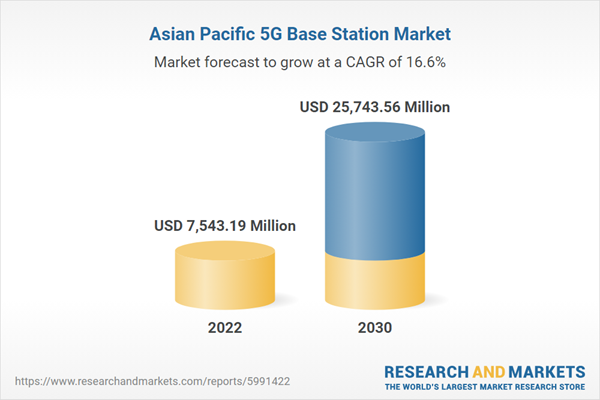Increasing 5G Subscriptions in Developing Countries Boost Asia Pacific 5G Base Station Market
The rate of 5G subscriptions is increasing in developing countries such as India, China, and Malaysia. According to the report of Ericsson company, India registered approximately seven million mobile subscribers during the second quarter of 2023, followed by China with five million. China has been highly focused on 5G and fiber broadband network rollouts in an effort to build a high-speed broadband platform that can support digital service developments. China recorded a 5G penetration rate of ~60% in 2022. China Mobile is the largest 5G operator, with 466.6 million 5G customers, nearly 55% of the total 5G customers.Also, China Telecom had 210.8 million 5G customers, about 25% of the country's 5G subscriber market, while China Unicom had 170.7 million, over 20% of the total subscribers. Furthermore, in September 2023, the Minister of Malaysia disclosed that the country had completed a total of 5,873 5G sites, with a total of 2.49 million 5G subscriptions. Therefore, the increasing rate of 5G subscriptions in several developing countries is anticipated to create lucrative opportunities for the 5G base station market growth during the forecast period.
Asia Pacific 5G Base Station Market Overview
The demand for 5G base stations in Asia Pacific (APAC) has been on the rise. APAC is home to a few of the world's most populous countries, and there has been a surge in smartphone adoption. For example, China, the world's most populous country, has a massive and growing smartphone user base. According to the GSM Association, nearly 1.3 billion users in China subscribed to a mobile service by the end of 2022. By 2025, China will be the first market with 1 billion 5G connections. 5G connections in the country will reach 1.6 billion by 2030, accounting for almost a third of the global total.In 2022, mobile services and technologies generated 5.5% of China's GDP-a contribution that amounted to US$ 1.1 trillion. Furthermore, governments of various countries across the region are investing in 5G infrastructure. For instance, in October 2023, the Prime Minister of India inaugurated the 7th Edition of the India Mobile Congress 2023 (IMC) at Bharat Mandapam in New Delhi. IMC is the largest telecom, media, and technology forum in APAC. The 5G lab equipment would include 5G SA infrastructure (mid-band), 5G SIMs, dongles, IoT gateway, router, and application server to meet lab needs, along with a management dashboard.
Similarly, there is a significant need for fiberization and additional telecom tower deployment in India. The Digital Infrastructure Providers Association (DI PA) highlighted non-compliance with Right of Way (ROW) rules by certain Indian states. DIPA stressed the importance of fiberization for 65% of towers and the deployment of an additional 1,200,000 towers between 2023 and 2024. Thus, the demand for 5G base stations in APAC is growing due to significant investments and deployments of 5G by both governments and telecommunications companies.
Asia Pacific 5G Base Station Market Revenue and Forecast to 2030 (US$ Million)
Asia Pacific 5G Base Station Market Segmentation
The Asia Pacific 5G base station market is categorized into component, frequency band, cell type, end user, and country.Based on component, the Asia Pacific 5G base station market is bifurcated into hardware and service. The hardware segment held a larger market share in 2022.
In terms of frequency band, the Asia Pacific 5G base station market is segmented into less than 2.5 GHz, 2.5 - 8 GHz, 8 - 25 GHz, and more than 25 GHz. The 2.5 - 8 GHz segment held the largest market share in 2022.
By cell type, the Asia Pacific 5G base station market is bifurcated into macrocell and small cell. The small cell segment held a larger market share in 2022. Furthermore, the small cell segment is subsegmented into microcell, picocell, and femtocell.
Based on end user, the Asia Pacific 5G base station market is segmented into industrial, commercial, and residential. The commercial segment held the largest market share in 2022.
By country, the Asia Pacific 5G base station market is segmented into China, Australia, India, Japan, South Korea, and the Rest of Asia Pacific. China dominated the Asia Pacific 5G base station market share in 2022.
Airspan Networks Holdings Inc, Alpha Networks Inc, Baicells Technologies North America Inc, Huawei Technologies Co Ltd, NEC Corp, Nokia Corp, Samsung Electronics Co Ltd, Telefonaktiebolaget LM Ericsson, and ZTE Corp are among the leading companies operating in the Asia Pacific 5G base station market.
Reasons to Buy:
- Save and reduce time carrying out entry-level research by identifying the growth, size, leading players, and segments in the Asia Pacific 5G base station market.
- Highlights key business priorities in order to assist companies to realign their business strategies.
- The key findings and recommendations highlight crucial progressive industry trends in the Asia Pacific 5G base station market, thereby allowing players across the value chain to develop effective long-term strategies.
- Develop/modify business expansion plans by using substantial growth offering developed and emerging markets.
- Scrutinize in-depth Asia Pacific market trends and outlook coupled with the factors driving the Asia Pacific 5G base station market, as well as those hindering it.
- Enhance the decision-making process by understanding the strategies that underpin commercial interest with respect to client products, segmentation, pricing, and distribution.
Table of Contents
Companies Mentioned
- Airspan Networks Holdings Inc
- Alpha Networks Inc
- Baicells Technologies North America Inc
- Huawei Technologies Co Ltd
- NEC Corp
- Nokia Corp
- Samsung Electronics Co Ltd
- Telefonaktiebolaget LM Ericsson
- ZTE Corp
Table Information
| Report Attribute | Details |
|---|---|
| No. of Pages | 118 |
| Published | June 2024 |
| Forecast Period | 2022 - 2030 |
| Estimated Market Value ( USD | $ 7543.19 Million |
| Forecasted Market Value ( USD | $ 25743.56 Million |
| Compound Annual Growth Rate | 16.6% |
| Regions Covered | Asia Pacific |
| No. of Companies Mentioned | 9 |









